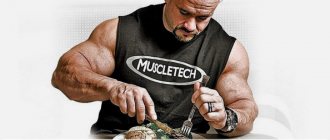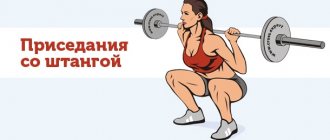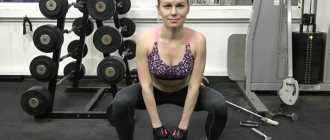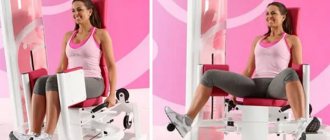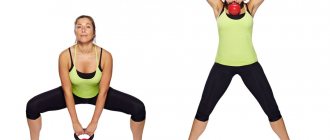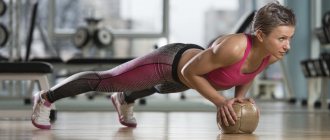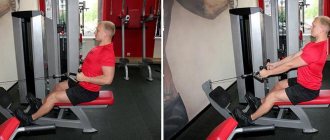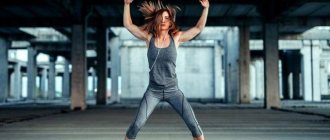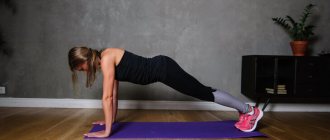Technique for performing dumbbell swings, standing to the side (for the development of the middle beam)
To perform the exercise, we need two dumbbells.
I warn you right away that heavy weights are not needed in this exercise.
Don’t chase weight, this exercise is not basic, but isolating (I remind you).
If you are chasing weight, you will either:
- get injured (worst case scenario)
- If you perform the exercise incorrectly (the middle beams will not work), basically only the trapezoid will work (because you will be cheating, i.e. helping yourself with your whole body)
Because We are interested in safe training of the middle beam - we do not take heavy weights.
For example: dumbbells weighing 3-4 kilograms at the initial stage will be with your head.
In general, remember: the weight must always be selected in such a way that the technique of performing a particular exercise is never violated. Technology always comes first.
Many people, to the detriment of technique, progress the load, and think that this is good.
In fact, no, this is not good guys, it’s good when you progress the load without losing the ideal technique for doing the exercise. This is really good.
Leg abduction in crossover
The main muscles that are involved in the work during crossover leg abduction training are the gluteus minimus, medius and maximus muscles. In different versions of the exercise, the biceps of the thigh or the inner surface of the thigh are included in the work.
If necessary (injuries or medical contraindications), you can replace squats or lunges with crossover swings. When performing this exercise, the joints do not wear out.
To perform various types of leg swings, a crossover is required. This is a universal simulator for block-type training. On such equipment you can perform exercises to work different muscle groups. Additionally, for performing exercises, it comes with equipment: cuffs, ropes, etc.
Crossover
Crossover - a simulator for performing leg swings
Crossover - a simulator for performing leg swings. Leg abduction in a crossover is a swing, with the leg fixed at the top point. It's important to choose the right weight to average twelve reps over five sets.
Okay, we've sorted out the weight, what's next?
- In general, we take dumbbells in our hands and straighten up (become exactly vertical).
- Do not hunch over under any circumstances; during the entire movement, your back should be straight and your shoulders should be straightened.
- Hands with dumbbells hang at the sides of your body near the front of your thighs (quadriceps).
- At the same time, the palms look at the side surfaces of the legs and are slightly turned inward.
- The head (gaze) is directed strictly forward (not up, nor down, not to the sides, strictly forward towards yourself).
This is all your starting position.
If you did everything correctly, you will look something like this (see photo below):
Now from this starting position you need to swing the dumbbells to the sides.
To do this, take a breath, hold your breath and, straining your shoulders, smoothly raise your slightly bent arms to the sides so that your hands holding the dumbbells are with your little finger up.
Those. we must also control the forearms, namely the hands, they should be with the little finger up.
Trainers often explain to their students that when you pick up dumbbells, imagine that you don’t have dumbbells in your hands, but a cup of water, and accordingly you want to pour water out of this cup. Do you understand?
You lower it down (turning it over), the water pours out, therefore the hands move (they also turn over, so that your little finger is pointing up).
This is an analogy (so you understand the essence), in the starting position you hold the cup (dumbbells) level (so that the water does not spill out), and when you lift the cup (dumbbells) to the sides (make swings), you turn your hands with your little finger up (you want to pour water).
Here, see the photo (I’ll try to explain and show you there):
The next very important point is that the movement should occur strictly in a vertical plane, along a line passing through the shoulders (not forward, not backward, but strictly to the sides).
And as soon as your elbows are at shoulder level (not higher, but at shoulder level), exhale and return your arms to their original position.
Those. I want to say that you can’t have your elbows higher than your deltoids, because your shoulders will also rise, and if your shoulders rise, the trapezoid will turn on and they will actively steal the load from the middle bunch of deltoids), but we don’t need that, right? after all?
That’s why we raise our elbows to shoulder level, not higher.
See photo below:
Well, something like this, friends. I hope I explained everything clearly (I really hope so), the exercise for beginners is quite difficult (in terms of execution technique), many people, as I already said, do it incorrectly (for months, or even some for years), but I hope it’s presented Today infa will help you solve this problem.
I also recommend watching a video demonstration of this exercise:
By the way, this exercise can be performed not only standing, but also sitting.
Sitting is a more isolated option (cheating is not possible).
The trick is that more advanced athletes use a little cheating in this exercise (slightly swaying the body), due to this they manage to lift a lot of weight, but cheating while sitting is not possible.
When sitting, you will not be able to swing your body (+ the exercise becomes slightly heavier).
Well, this is already so, the info is purely for informational purposes.
In my opinion, the standing option is better (due to the fact that you can use a little cheating), but this technique is not for beginners or even for an average level of training, it is only for experienced athletes.
To some extent, it is better for beginners to perform the exercise while sitting.
Well, here you need to watch your technique (if your standing technique is perfect, then there is not much difference).
Dumbbell press sitting and standing.
The technique in these exercises is identical, but when performing the exercise while sitting, you deprive yourself of the opportunity to help yourself, at a moment of fatigue, to “throw” the dumbbells using your leg muscles. That is, the exercise can be performed while standing with a little cheating, but while sitting it won’t work, and it becomes more “isolating.” In the picture I am performing this exercise on a regular chair, without a back, at home. Ideally, perform it on a chair with a comfortable back, so that there is support and you can turn off all non-essential muscles from work.
Technique for performing dumbbell swings while standing on an incline to develop the rear deltoids
This exercise can be performed:
- like standing bent over
- and sitting on a bench at an angle
I prefer the option sitting on a bench, why? => simply simpler)), because you don’t need to stand with your butt facing the entire room (the lower back is tense, but when you sit, the lower back is relaxed), that’s why it’s easier.
This is purely my opinion, I know many people who, on the contrary, like to do the exercise while standing, so try both options and choose the appropriate option for yourself.
Also, the rear delts are often simply absent in most ordinary people.
Because, most often, many people forget about them (they don’t do any exercises).
In addition, there are not so many exercises for the targeted development of the posterior delta bundle (to be more precise, there are very few of them, God forbid you can count them on the fingers of one hand).
In addition, many athletes are chasing weight and working not with the rear deltoid, but with other muscles.
- In general, we take dumbbells in both hands (the weight is not heavy, as I already said in the exercise, swing dumbbells to the sides while standing, don’t chase the weight, weight, of course, is important, but only without losing the correct technique for performing the exercise).
- In short, take dumbbells in your hands, palms facing each other (i.e. parallel grip), and lean forward so that your torso is parallel to the floor.
- The back should be straight, slightly arched in the lower back.
This is your starting position (the point from which you will begin to perform the exercise), if you did everything correctly, then you will look something like this (see photo below):
So, in this initial position, the arms with dumbbells are hanging, but not with straight arms, but slightly bent at the elbows (slightly bent). This is where the upward movement (pivot) begins (to the top point).
How does it happen? (wiring from the bottom point up)
- Next, all the same actions as in the exercise of swinging dumbbells to the side while standing (for the development of the middle beam).
- Those. we stand in a tilted position (torso is almost parallel to the floor)
- The gaze is directed downward (to the floor), by the way, you can rest your forehead on something, this will reduce the load on the lower back, it will become much easier for you to stand in an inclined position)
- Next, we inhale, hold our breath and, straining our shoulders, smoothly raise our slightly bent arms to the sides so that your hands holding the dumbbells are with your little finger up.
See the photo below (as it should happen for you):
The next very important point is that the movement should occur strictly in a vertical plane, along a line passing through the shoulders (not forward, not backward, but strictly to the sides), and as soon as your elbows are at shoulder level, exhale and return your hands to the starting position.
At the bottom point, do not touch the dumbbells to each other, keep the distance.
I also recommend watching a video demonstration of this exercise:
Work of muscles and joints
The main muscle groups working when performing swings in the simulator are the deltoids, not only the middle ones, but also the rear ones, only to do this you need to lean forward a little. It goes without saying that the trapezius muscle is also innervated, and the abdominal muscles and long back muscles serve as stabilizers. In general, the innervation of any muscle groups except the latissimus dorsi is not dangerous. The latissimus muscles can take the load away from the deltoids and will do this if you lower your elbows below your hands, since in this position it is more difficult to innervate the shoulders, and the latissimus dorsi muscles are easier, while the latissimus dorsi are stronger than the deltoids, so they will happily “steal” » the entire load.
The only working joint is the shoulder, so the exercise is isolating, but this is not bad, it just needs to be taken into account. The bottom line is that conditioning exercises simply don't need to be done in a strong style, they need to be done with a moderate weight with which the athlete can reach positive failure at 8-15 reps. If you try to use heavier weights, then due to the fact that “cheating” is impossible in the lower phase of the range of motion in a sitting position, you will simply shift the load to the latissimus dorsi muscles, lowering your elbows, or not perform the exercise at all. However, if you have a training partner, then he can help you in the lower phase, or you can work in a shortened amplitude, but using such methods of suppressing muscle fibers is already at an advanced level.
Execution technique
No matter which option you choose (I hope it will be all three), the technique will be the same.
- Select the appropriate dumbbell weight and take the starting position.
- Focus your attention on the work of the middle delta bundles.
- As you exhale, forcefully spread the dumbbells to the sides, trying to raise your elbows as high as possible. When lifting the dumbbells, you need to turn them so that your thumbs point down and your little fingers point up.
- Without pausing while inhaling, bring the dumbbells towards each other or towards your thighs.
- Repeat the specified number of times.
The technique is extremely simple. The main point is the rotation of the dumbbells during the lift. This is achieved by spreading the elbows to the side and lifting them just above the shoulders. Then your thumb will point down and your little finger will point up. Imagine as if you are turning a bottle over to pour water.
The main nuances of shoulder pumping
Let’s summarize and list the main points regarding performing shoulder exercises:
- It is recommended to work out each delta bundle with 1-3 exercises.
- The workouts should not be done every day, as the muscles need several days to rest. As part of a general split-based program, one shoulder workout per week is sufficient. If this is a specialization for this muscle group, it makes sense to split the beams up on different days, but also only train them once a week.
- Be sure to start your session with a warm-up.
- All efforts (pull, press) are done while exhaling. Inhale as you relax your muscles.
- Perform smoothly, without jerking.
- If you do swings, do at least 12-15 repetitions. Many people do 8-10 swings in about 10 seconds, which is not enough to properly work out the muscles.
- Do not throw the barbell or dumbbells in the negative phase. Go through this part of the movement under control.
Working muscles when raising dumbbells to the sides
Some athletes confuse dumbbell lateral raises with bent over swings. But these are two completely different exercises, although they are aimed at developing the deltoid muscles. Swings, due to the forward tilt of the torso, load the posterior bundle. Breeding loads the middle part of the deltas, since the athlete keeps his back straight.
- Middle head of deltas. This is our main muscle, the development of which this exercise is aimed at. Of course, a small share of the load falls on the other two beams, front and back. But it is too small to be taken into account.
- Trapezoid. More precisely, not the entire trapezius, but mostly its upper part, acts as an assistant muscle. The main thing to remember is, “If during the lateral raise you feel the trapezoid hammering, then your execution technique is incorrect.” This happens due to the incorrect position of the shoulder blades. When spreading, they should be relaxed and separated from each other. Then it will be very difficult to load the trapezius and the lifting of the dumbbells will be done at the expense of the middle bunch of deltas.
- Supraspinatus muscle. This is a small muscle. Located under the deltoid, in the upper fossa of the scapula. It does not turn on immediately, but only when the shoulder rises above the horizontal line. This muscle helps the middle bundle lift the weight of dumbbells.
- Press and lumbar straighteners. They help in some cases to maintain an even position of the body. They work statically.
These are the muscles we will focus on during this exercise. It is also important to focus on the work of the middle deltas. This will help your brain use exactly the neural connections you need.

